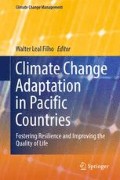Abstract
Women and girls are disproportionately affected by the impacts of climate change in the Pacific due to prevailing gender inequalities. Meanwhile, the participation and leadership of women in climate change adaptation has been identified globally as critical for fostering resilience in families, communities and nations.
Aided by case studies from across the Pacific, this paper examines the differentiated impacts of climate change on gender and the actual and potential role of women in climate change adaptation and disaster risk reduction. It evaluates regional capacity for gender responsive climate change action in the areas of policy, institutional arrangements, implementation and practice, knowledge and participation, to inform future decisions by development agencies, governments and donors.
Research findings show that while the importance of gender equality in relation to climate change is recognised in theory, the value of active participation of women and women’s groups’ is largely overlooked in practice in the Pacific, at local and national levels. Recommendations are made for more meaningful incorporation of gender equality into climate change policy, planning and processes. The paper identifies a number of examples where a gender responsive approach aids effective climate change adaptation, and identifies measures through which gender equality and women’s empowerment can be strengthened to substantially build resilience to climate change.
Access this chapter
Tax calculation will be finalised at checkout
Purchases are for personal use only
Notes
- 1.
Cyclone Evan: Samoa and Fiji 2013, Cyclone Lusi: Vanuatu 2014, Cyclone Ian: Tonga 2014; flash flooding: Solomon Islands 2014; Cyclone Pam: Vanuatu and Tuvalu 2015, Cyclone Maysak: Federated States of Micronesia 2015; Cyclone Winston: Tonga and Fiji 2016.
References
Asian Development Bank. (2014). Gender-based violence in Asia and the Pacific. Retrieved May 29, 2016 from http://www.adb.org/news/infographics/gender-based-violence-asia-and-pacific.
Bernard, K. (2013). Tuvalu gender assessment of NAPA1/+Project. Suva: UNDP.
Enarson, E. (2000). Gender and natural disasters: Working paper no. 1. In Focus Programme on Crisis Response and Reconstruction. Geneva: ILO.
Enarson, E., & Fordham, M. (2001). From women’s needs to women’s rights in disasters. Environmental Hazards 3(3), 16–139. Cambridge: Taylor and Francis.
Government of Samoa. (2008). National policy on combating climate change. Apia, Samoa: Government of Samoa.
Government of Samoa. (2013). Post disaster needs assessment cyclone Evan 2012. Apia, Samoa: Government of Samoa.
Government of Solomon Islands. (2012). National Climate Change Policy 2012–2017. Honiara: Government of the Solomon Islands.
Government of the Cook Islands. (2012). National policy on gender equality and women’s empowerment. Rarotonga, Cook Islands: Office of the Prime Minister.
Government of the Republic of the Marshall Islands. (2007). National action plan on disaster risk management 2008–2018. Majuro: Government of RMI.
Government of the Republic of the Marshall Islands. (2011). National climate change policy framework. Majuro: Government of RMI.
Government of the Republic of the Marshall Islands National Disaster Management Committee. (1997). National disaster management plan. Majuro: Government of RMI.
Government of Tuvalu. (2014). National gender policy 2014–2016. Funafuti: Government of Tuvalu.
Government of Vanuatu. (2015a). National gender equality policy 2015–2019. Port Vila: Government of Vanuatu.
Government of Vanuatu. (2015b). Climate change and disaster risk reduction policy 2016–2030. Port Vila: Government of Vanuatu.
Government of Vanuatu. (2015c). Post disaster needs assessment: Tropical cyclone Pam, March 2015. Port Vila: Government of Vanuatu.
International Labour Organisation (ILO). (2009). Decent work country programme: Tuvalu. Funafuti: Government of Tuvalu.
Kilsby, D., & Rosenbaum, H. (2012). Scoping of key issues in gender, climate change and disaster risk management to inform proposed UN women five-year, five-country Pacific programme. Internal briefing document, Suva: UN Women.
Kingdom of Tonga. (2014). Safety and protection assessment of tropical cyclone Ian—Ha’apai. Government of Tonga: Tonga. Nuku’alofa.
Kingdom of Tonga. (2015). Climate financing and risk governance assessment. Unpublished.
Live and Learn. (2010). Navigating false seasons: A research of aspirations and perceptions toward climate change adaptation for food security in Western Pacific Island communities. Honiara: Live and Learn Environmental Education.
Morioka, K. (2012). A climate for change: Understanding women’s vulnerability and adaptive capacity to climate change from ActionAid’s rights-based approach—case studies from Papua New Guinea and Solomon Islands. Sydney: Action Aid.
Nellemann, C., Verma, R., & Hislop, L. (2011). Women at the frontline of climate change: Gender risks and hopes, a rapid response assessment. Norway: UNEP, GRID-Arendal.
Peterson, K. (1997). From the field: Gender issues in disaster response and recovery. Natural Hazards Observer 21(5), 3–4. Boulder: University of Colorado.
Secretariat for the Pacific Community (SPC). (2012). Regional stocktake of the gender mainstreaming capacity of PICs. Retrieved May 22, 2016 from http://sids-l.iisd.org/news/spc-publishes-gender-mainstreaming-assessments/.
UNISDR. (2013). Hyogo framework for action on DRR 2011–2013. Asia Pacific Synthesis Report. Suva: United Nations Office for Disaster Risk Reduction.
United Nations University and Alliance Development Works. (2014). World risk report 2014. Bonn, Germany: Alliance Development Works and UNU Institute for Environment and Human Security. Retrieved May 29, 2016 from http://www.worldriskreport.com/uploads/media/WorldRiskReport_2014_online-II_01.pdf.
Author information
Authors and Affiliations
Corresponding author
Editor information
Editors and Affiliations
Rights and permissions
Copyright information
© 2017 Springer International Publishing AG
About this chapter
Cite this chapter
Aipira, C., Kidd, A., Morioka, K. (2017). Climate Change Adaptation in Pacific Countries: Fostering Resilience Through Gender Equality. In: Leal Filho, W. (eds) Climate Change Adaptation in Pacific Countries. Climate Change Management. Springer, Cham. https://doi.org/10.1007/978-3-319-50094-2_13
Download citation
DOI: https://doi.org/10.1007/978-3-319-50094-2_13
Published:
Publisher Name: Springer, Cham
Print ISBN: 978-3-319-50093-5
Online ISBN: 978-3-319-50094-2
eBook Packages: Earth and Environmental ScienceEarth and Environmental Science (R0)

